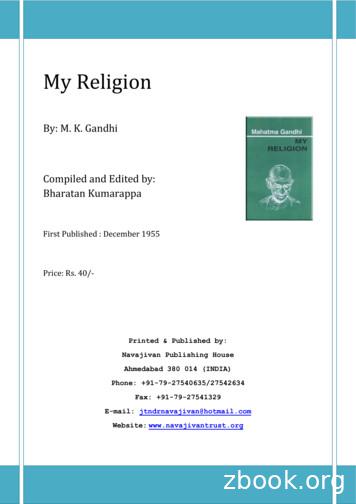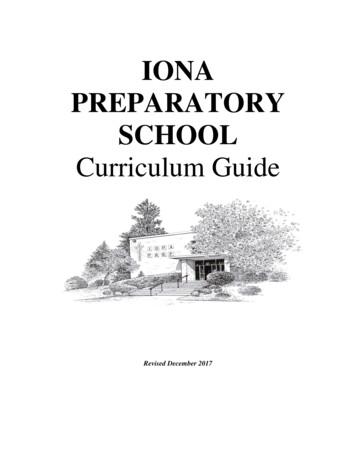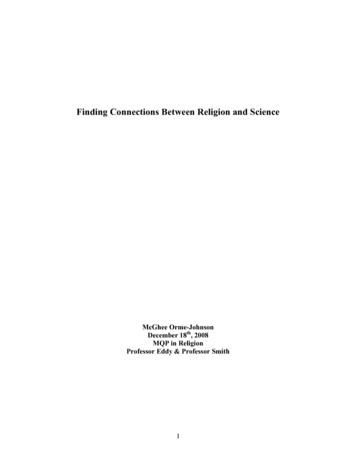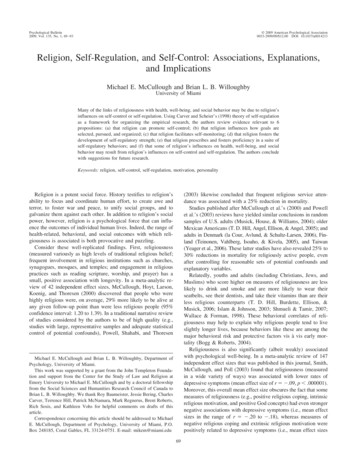A Definition Of Religion, And Its Uses
A Definition of Religion, and its UsesAuthor(s): Robin HortonSource: The Journal of the Royal Anthropological Institute of Great Britain and Ireland, Vol.90, No. 2 (Jul. - Dec., 1960), pp. 201-226Published by: Royal Anthropological Institute of Great Britain and IrelandStable URL: http://www.jstor.org/stable/2844344 .Accessed: 08/07/2011 06:26Your use of the JSTOR archive indicates your acceptance of JSTOR's Terms and Conditions of Use, available at ms.jsp. JSTOR's Terms and Conditions of Use provides, in part, that unlessyou have obtained prior permission, you may not download an entire issue of a journal or multiple copies of articles, and youmay use content in the JSTOR archive only for your personal, non-commercial use.Please contact the publisher regarding any further use of this work. Publisher contact information may be obtained at erCode rai. .Each copy of any part of a JSTOR transmission must contain the same copyright notice that appears on the screen or printedpage of such transmission.JSTOR is a not-for-profit service that helps scholars, researchers, and students discover, use, and build upon a wide range ofcontent in a trusted digital archive. We use information technology and tools to increase productivity and facilitate new formsof scholarship. For more information about JSTOR, please contact support@jstor.org.Royal Anthropological Institute of Great Britain and Ireland is collaborating with JSTOR to digitize, preserveand extend access to The Journal of the Royal Anthropological Institute of Great Britain and Ireland.http://www.jstor.org
A DefinitionofReligion,and itsUsesROBINHORTONIN RECENT BRITISH ANTHROPOLOGY three principal types of working definition havebeen used in approaching the comparative study of religion. The firsttreatsthe term'Religion' as lendingitselfwithdifficultyto furtherdefinitionand as coveringan area ofhuman activitywhich lacks sharplydelineated boundaries; where such a point of viewprevails, the reader is simply asked to accept as 'religious' any phenomena which theauthor happens to select for treatmentunder this heading. The second type treats'Religion' as referringto a class of metaphorical statomentsand actions obliquelydenoting social relationshipsand claims to social status. The thirdtype treatsthe termas referringto commerce with a specificclass of objects, i.e. 'Religion is the belief inspirits'or 'Religion is the beliefin the supernatural'.As theystand, I believe all of theseand in thispaper I shall followup theircriticismwiththeapproaches are unsatisfactory,proposal of an alternativedefinition.Definitionsbeing mere tools towardsthe discoveryof empirical regularities,I shall of course tryto show that the alternativeproposed is ofvalue in termsof the hypothesesand questions it suggestsabout the determinantsofreligiousforms.The approach which would press on with the scope of the term 'Religion' leftundefinedhas had some worthyadvocates-among them,ProfessorNadel, author of oneof the most comprehensiveanalyses of an African religious systemproduced to date.Accordingto Nadel (I 954, pp. 7-8),'Whicheverway we proposeto circumscribethe provinceof thingsreligious,we arebound to encountera borderzone whichdefiesprecisea prioriallocationon thisor thatside oftheboundary.To be sure,thisresidueofinaccuracyis entailedin thebroad viewofreligionwhichwe made our startingpoint.But no otherstartingpointseemsfeasible.in a particularculturethatBluntlystated,whatwe setout to do is to describeeverythinghas a bearingon religion.And since"religion"is preciselyone ofthosewordswhichbelongto themoreintuitiveportionsofourvocabulary,and hencecannotbe givena sharpconnotation,we have no choice but to feelour way towardsthe meaningit shouldhave ingivencircumstances.We mustnotriskomittinganythingthatmightbe relevant;theriskwe have to take is thatofincluding,besides"religionproper",also that "border" uedor all too crudelyattempted;andofscienceaimingtoohighor incompletelyseveredfrommysticthought.'at least theNow thisis not enough. Firstof all, I believe thatfornon-anthropologiststerm 'religion' has a much clearer connotationthan is suggestedhere. Secondly, to goahead with the comparative study of religion while leaving the scope of the term undefined is to behave in a self-stultifyingway; for until some fairlyprecise criteria ofinclusion of phenomena in the denotation of 'religion' have been given, it is impossibleto specifythosevariables whose behaviour we have to tryto explain in our study.Untilsuch criteria have been given, it is also possible to carry on an endless and entirelybarren argumentabout whethera givenitemofhuman behaviour is or is not religious.The second typeof approach makes up forthe firstin positivenessof attack; but, in201
202ROBINHORTONdefiningreligiousactivitiesas an oblique way of referringto relationsbetween men, itgrosslydistortsfact. The point of view is certainlyrespectable in sociological studies;introducedby Durkheim (1915) and adopted with variationsby Radcliffe-Brown,it ismaintained in essentialsby many contemporaryfigures.E. R. Leach, one of the mostforcefulofthese,has statedthe positionas follows(Leach 1954):'Actionsfallintoplace on a continuousscale. At one extreme,we have actionswhichare d simple;at theother,we haveactionswhichare nctional.Fromthispointofview,techniqueand ritual,profaneand sacred,do faction.'Leach looks upon activitieswhich would commonlybe called 'religious' as fallingon to the sacred, aesthetic, technically non-functionalend of his scale. He says:'It is theseaspectswhichhave meaningas symbolsofsocial statusand it is thesewhichI describeas ritualwhetheror not theyinvolvedirectlyany conceptualizationof theor themetaphysical. In sum,then,myviewhereis thatritualactionandsupernaturalbeliefare aliketo be understoodas ly, Leach broadens the traditionalDurkheimian view by admittingthe symbolization in mythand ritualofsocial conflictsas well as social solidarities:'Since any social system,howeverstable and balanced it may be, containsopposingfactions,thereare boundto be differentmythsto le. Mythand ritualis a languageofsignsin termsofwhichclaimstorightsand statusare expressed,butitis a languageofargument,nota chorusofharmony.'It will be noticed that in these lines Leach lumps togetherperformancesof the sortcommonlylabelled religiouswithothersgenerallydescribedas non-religiousceremonials.Here, however, we shall be concerned solely with the applicability of his ideas to religious activity.Now thereis no doubt that in most culturesreligiousritual and religiousmythologydo sometimesget used as symbolsofsocial relationshipsand social alignments;but as tohow far such use is integral or incidental to the nature of religious activity,it may beusefulto answerby referenceto a West Africanreligioussystemwithwhich I am familiar-that ofthe Kalabari ofthe Niger Delta.In the Kalabari state,which consistsof a congeriesof primarysegmentsor 'houses'controlledby chiefs,and a royal segmentwhose core is the lineage which provides theking, the cult of the chieflyand royal ancestors is one of the principal sanctions ofauthorityat both 'house' and state level. This ancestral cult is particularly rich inactivitiesinterpretedby the congregationsthemselvesas symbolicof social and politicalalignments.Thus, formerly,when a house chiefconducted ritesin honour of the deadchiefsof his line, the congregationof house memberswould be supplementedby a number ofchiefsofotherhouseswho would presentramsforsacrificeto theirhost'sancestors.even though the latter were in no blood relationshipto them. Asked why the housemembersattended such a rite,Kalabari informantssay that it was because theywantedtheirdead mastersto bringthemwealth and freethemfromsickness.On theotherhand,the presence of chiefsfromother houses who presentedrams is explained by saying 'itwas a sign that theywished to remain friendsof the feast-givingchief'. Again, when a
ADEFINITIONOFRELIGION,ANDITSUSES203ofa seriesofnewkingsucceededto theheadshipofthestate,he had to maketheofferingramsto thespiritofhispredecessor.The firstoftheseofferingswas ofa ramprovidedbyhimself:thiswas followedby thecuttingoframsbroughtto himby each ofthechiefsofKalabari hevariousvillagesit is said, 'theunderKalabari protection.Of thissuccessionofsacrificialpresentations,ofa .'bringingas a symbolHere,then,we have examplesoftheact ofsacrificebeingusedexplicitlyof social alignmentin the best Durkheimianmanner.But what would Kalabari sayin thispurelysymbolic,about a man who indulgedin the actionsofancestor-worshipgesturalway, yetmerelyshruggedhis shouldersand did nothingwhentold thathispainfulillnesswas due to ancestralanger and could be broughtto an end only bysacrifice?Like us, I suspecttheywould say that the man no longerbelievedin hisancestors:indeed,I have sometimesheardhintsto thiseffectin the case of educatedmen returnedfromabroad to take up a chieftainship,who have erswithoutapplyingthecultto thevicissitudeslife.More commonis istianin Kalabari. The variousformsofChristianculthave becomeimportantcult-practicesofsymbols highstatusin ianideologywith the Westerneducation,which chiefsfroman early date, using theirriches,gave to theirsons.Many chiefs,therefore,makea carefulparadeoftheirchurchadherence,especiallyon occasionsofpublicChristianritual.When somecrisisofmisfortunecomestheirway,theyare apt to go surreptitiouslyto consulta divinerand, as aIn suchresultofhis advice,to makea sacrifice,eitherto thedead or to a water-spirit.Kalabari say as readilyas we shouldthatthepeople concernedare notcircumstances,do notbelievein theChristianGod. In esymbolsoffactionalallegiance;and hereagain, examplessuggestthatwhereitis seento be thisand nothingelse,theKalabari reactionis to saythatthoseconcernedare notChristians.I am remindedin particularofthecase ofa Kalabari villagewhoseheadmanand his descent-groupwerein chronicoppositionto anotherdescent-groupwhichincludeda prominentwater-spiritmedium.When thetimecame roundforthelatterto givetheperiodicfestivalforhisspirit,theheadman,who had been invitedtoattend,refusedto do so on thegroundthat,as a Christian,his God wouldnotallowit.Althoughhe was in facta fairlyregularchurchattender,manyofthevillagerson bothsidesofthecleavageinterpretedhisreplyas a signofhisantagonismto thegiverofthefestivaland hisgroup.Peoplefeltthisinterpretationto have been vindicatedwhentwodays laterhis wifewho had been ill forsomeweeksreacheda crisis,and he actuallycame quietlyto the mediumto consulthis spiritabout what he shoulddo. They allagreed thathe was, in fact,no more a Christianthan thosewho stayedaway fromchurch.ofbeliefin aWherethena personis seento be usinga prayer,sacrifice,or professiongod merelyto make a statementabout social relationsor about his own structuralalignment,Kalabari say thattheone concerned'does not reallybelieve'.To findoutwhathe reallybelieves,theywatchto see whichofthegodshe goesto forhelpwiththetroublesofhislife,whichofthegodshe communeswithwhenhe is offparade.In the Near East and Europe,the historyofJudaeo-Christianityis fullof similar
204ROBINHORTONcondemnstheScribesand ritualas a status-symboland pointsto theirattitudeas theessenceofirreligion.And Christianthetruebelieverwithone whocontrastedpastorsup to our own day have continuallyin a Pharisaicway.One howmuchthesamereactiontoin .ofDurkheimianSuch a reaction,ofcourse,is a flatrefutationideas.In thistheoretical'I believein God' implies'I subscribeto thesystemofsocialtradition,thestatementthisstateis part; and, in mentand adoptionofa certainsocialment,I ment'.Hence, a man's religiousbelief-statementsshouldbe verifiablesolelybyor takeup thealignwatchingto see whetherhe does,in o by such statements.The instanceswe have raisedabove,drawnbothfroman Africancultureand fromone nearerhome,suggestthattheveryreverseis thecase.All thismustsoundverytriteand obviousto theaveragenon-anthropologistofanyculturewho, if not religioushimself,has been broughtup in an environmentwhichincludedone or two Christiansor othercult-practitioners.But forthosebroughtupacademicallyin theDurkheimiantraditionand possiblyalso livingin a largelyagnosticsocialenvironment,it seemsthatthesethingscan stillusefullybe said. In effect,definingreligionas structuralsymbolismcomesto muchthesamethingas definingthesubstance'linen'in termsofitsoccasionaluse as a flag:thesymbolicfunctionis as incidentalto thenatureofthefirstas it is to thatofthesecond.The truthofthematter,surely,is this.One ofthemostimportantforone thingbecomingthesymbolofanotherpre-conditionsis the regularassociationof the two in collectiveexperience.Now, to the extentthatcertainreligiousactivitiesand professionshave becomeassociatedin the collectiveexperienceof a givenculturewithcertainstatus-positionsand social groupings,so thesethingsmay come to standas symbolicforsuchpositionsand groupings;but thissymbolic functionis onlya by-productofreligiousactivityand is onhas nothingto do withsymbolism.This,I think,is amostimportantpoint:forit wasjust thisco-ordinationofgodsand theircultswiththeenduringgroupsofa societythatDurkheimand his successorsseemto have feltinexplicable on any basis otherthan thatof the assumptionthatreligionwas essentiallystructuralAsI esystemsofgodto-groupco-ordinationfoundin so manysocietiescan be just as readilyexplainedonthebasisofa definitionofreligionwhichconformsperfectlywellto moregeneralusage.Of thethreeapproachesdealtwithhere,I have lefttilllastthedefinitionofreligionas beliefin a certainkindofobject,whetherthisbe 'spirits'or 'the supernatural'.Thedefinitionofreligionas 'beliefin spirits'has had currencyas a workingconceptsomewhereor otherin anthropologyever sinceTylor (I871), survivingthe come-and-goprocessionofmoreexoticideas withitsrobustclosenessto commonusage. In fact,theI shallput forwardis so closeto Tylor'sthatI hesitateto call it in anywaydefinitionnew. 'Beliefin spirits',however,is just a littletoo vague forour purposes;and beforegoinganyfurther,we shalldo well to weed out thatare ofvalue. One wayin whichthisformulacan misleadis by
ADEFINITIONOFRELIGION,ANDITS205USESmaking us thinkof 'spirits' as the label fora class of objects characterized by a specificmode of existenceor in termsof specificconditionsof knowledgerelevantto the makingof true statementsabout them. One is easily led into this mistake by conventionalassociationsofthe word 'spirit'withotherssuch as 'immaterial'.Now what happens ifwe followup thiserrorby tryingto definethe mode ofexistenceand conditionsof knowledge common to all those entitiesgenerallytermed religious?We find,firstofall, thatwe can point to no singleontologicalor epistemologicalcategorywhich accommodates all religious entities. Secondly, we find that every major ontological and epistemologicalcategorywe can devise contains religiousas well as secularentities.Let us take a few illustrativeexamples fromAfricancultures. First of all, fromtheNuer, as describedby Evans-Pritchard(I956, pp. 3I5-i6):Spirit.As Spiritcannot be'Nuer philosophyis . dominatedby the idea of kwoth,directlyexperiencedby thesenses,whatwe are consideringis a conception.Kwothwouldand could notbe thoughtofby Nuer at all wereit notindeed,be entirelyindeterminatethatit is contrastedwiththeidea ofcak,creation,in termsofwhichit can be definedbyreferenceto effectsand relationsand by the use of symbolsand metaphors.But theseare onlyschemata,as Otto putsit,and ifwe seekforelucidationbeyondthesedefinitionsterms,a statementofwhat spiritis thoughtto be likein itself,we seekofcoursein vain.Nuer do not claim to know.They say thattheyare merelydoar,simplepeople,and howbycan simplepeopleknowabout suchmatters?Whathappensin theworldis determinedThis muchtheyknow,but noSpirit,and Spiritcan be influencedbyprayerand sacrifice.more.epistemologicalstatus,we may turnto theFor religiousobjects of radically differentKalabari ofthe Niger Delta. In the Kalabari view oftheworld two main epistemologicalcategoriesobtain-the firstthat of bodies, the second that of what we may call 'spirits'forwant of a betterword. Bodies are thoughtof by Kalabari in much the same termsaswe thinkof material objects. Spiritsare ratherdifferent.To the ordinaryman, theyareknown only by theireffects:he can neithersee them,nor hear them, nor indeed haveany direct experience of them. Such experience can be had only by expertswho haveundergone a seriesof herbal treatmentsknown as 'clearing the eyes and ears', and canin consequence both see and hear spirits.These objects, nevertheless,are thoughtof asfrombodies. Thus, whereas a Kalabari would bean orderof existenceentirelydifferentas contemptuous as we should of someone who talked about a table as being in twoplaces at one time, he would not be so of someone who said the same thingof a spirit:forinstance,the dead, who are thoughtto exist 'in spirit'only,can be talked ofwithoutany sense of contradictionas both 'in the skywith God' and as 'in the burial ground'where expertsmay communicate with them. In thisrespectthey,like Nuer Spirit, arecompared with the wind: they are anywhere and everywhereat once. In Kalabariculture,however,the realm of practiceswhich the eye of common-sensewould identifyas religiousis not directed to a range of objects co-extensivewith that covered by theterm 'Spirits'. Of the three categories of religious objects which we may call Deads,Village Gods, and Water-People, the firsttwo are seen as existing'in Spirit' only,whilethe last like human beingshave both bodies and spirits:unlike Deads and Village Gods,theycan be seen, heard, touched, and smeltby anyone who happens to crosstheirpath0R.A.I.J.
2o6ROBINHORTONin therivers.They are not likethewind: theycan be talkedof as inhabitingdefinitelocalitiesas the Deads and the Village Gods cannot.Many othergods of primitivetheKalabari Water-Peoplein theirthorough-goingpeoplescouldbe citedas sA definitionofthemodeofexistenceand conditionsobjectsand includedbothNuerthemfromnon-religiouswhichat once tand Kalabari Water-PeoplemustnecessarilyFurtherthanthis,it seemstrueto saythattheassertions.have to includecontradictoryofanyreligiousobjectone can thinkofare sharedwithcharacteristicsepistemologicalsome class of non-religiousobjects.In the case of Kalabari Water-Peoplethisseemstheyare ofthesameorderas llyNuer Spiritand similarconceptionswould seem at firstsightto sharetheirmode ofexistencewithno secularobjects;but as Gellnerlhas shown,even entitiesofthistypecategorywithotherswhich are not religious,e.g. withfall into an epistemologicalofmodernsciencesuchas atoms,molecules,and alphaentitiescertainofthetheoreticaland statementsparticles.These entitiesare definedas incapableofdirectobservation,ofby thebehaviourofcertaincharacteristicsaboutthemcan onlybe said to be verifiedobservablephenomenawhichare assumedto be 'symptoms'of variationsin the unobservables(Kneale I952, pp. 89-I 13). Thus theincreasingpressureofa gas whichisofthetheorythatmoleculesvolumeis indirectconfirmationheatedin a vesselofconstantgiven the assumptionthat theincreasetheirvelocitywithincreasein temperature,oftheimpactsobservablepressureofa gas on thewallsofitsenclosureis thesymptomofcountlessunobservablemoleculeson thiswall and thattheincreasein pressureis asymptomofincreasein molecularvelocity.Here,just as withthe Nuer conceptionofSpirit,the behaviourof observableobjectsis held relevantto the truthofwhat is inprincipleunobservable,but only by virtueof an assumptionthat variationsin theof certainvariationsin the unobservable-an assumptionobservableare symptomsjustification.whichin bothcasescan haveno furtherIt appears,then,thatevenin thecase ofthoseentitieswhosemodeofexistenceandfromthe sphereof ordinary,solid,conditionsof knowledgeremovethemfurthestwe hings,The morevaluableSo muchforthe misleadingimplicationof Tylor'sdefinition.implicationis thatof analogybetweenhumanbeingsand religiousobjectsgenerally.Extendingthisfromthe contextofbeliefto the contextof action,we can say s thatitleadsus to compareinteractionand interactionwithhumanbeings.This,ofcourse,will encounterverystrongobjections.It willbe said thatso manydivide the two typesof interactionas to make any comparisoncrucial differencesand actionshave longbeen drawnto regardthesentimentsAnthropologistsworthless.in kindfromthoseevokedby secularobjects:evokedby religiousobjectsas differentfromthispointofviewcame to theforewithMarett(I9I4) and receivednewstrengththe workof the theologianOtto (I928). But it seemsdoubtfulif the theoryof speciofand lyreligioussentimentsawe and reverencewhichwe tendto regardas verycloselyassociatedwithreligiousin thesentimentssituationsin our own cultureare replacedby some verydifferent
A DEFINITIONOFRELIGION,ANDITSUSES207religionsof other parts of the world such as West Africa.A complex of sentimentsandemotions common to all religions everywhereis as much of a chimera as an epistemological categorywhich will contain all religiousobjects. Even withinthe bounds ofthe Christian tradition,evidence against the existenceof a specificallyreligious sentiment seems patent in the fact that so many who have claimed close contact with Godhave not foundit necessaryto coin any special new termsin describingthe feelingsandemotionsthatsuch contact evoked.All thiswas noted a long time ago by William James who, forsome curious reason,is commonlymisreportedby anthropologistsas having thoughtthe essenceofreligiontoconsistin some peculiar kind of organic thrill.I can hardly do betterthan quote him(James i902, pp. 28-9):'Consideralso thereligioussentimentwhichwe see referredto in manybooks as ifitwere a singlesortof mental entity. The momentwe are willingto treatthe term"religioussentiment"as a jectsmay arousein alternation,we see thatit probablycontainsnothingofa psychologicallyspecificnature.Thereis religiousfear,religiouslove,religiousjoy and so forth.But religiousloveis onlyman's natural emotionof love directedto a religiousobject; religiousfearis only theordinaryfearofcommerce,so to speak,thecommonquakingofthe humanbreastin sofaras the notionof divineretributionmay arouse it; religiousawe is the same organicthrillwhichwe feelin a forestat twilightor in a mountaingorge;onlythistimeit comesover us at the thoughtof our supernaturalrelations;and similarlyof all the varioussentimentsthatmaybe called intoplayin thelivesofreligiouspersons.As thereseems to be no one elementaryreligiousemotion,but onlya commonstorehouseof emotionson whichreligiousobjectsmay draw,so theremightconceivablyalsoproveto be no one specificand essentialkindofreligiousobject and no one specificandessentialkindofreligiousact.'Though the thinnessof the case for a religious sentimentshould encourage us tomore exploration of the parallels between man-to-manand man-to-godrelationships,we must firstdeal with some apparently wide-spread contrasts between ordinaryhuman social activityand religiousbehaviour. Thus, it is undeniable that a great dealof religious behaviour is highly stereotyped,while activityoriented to other humanbeings contrasts with it in greater flexibility.Again, much religious behaviour isgoverned by the idea that its objects can be compelled by the actors involved; whilebehaviour oriented to other human beings usually contrastswith it in a much greaterdevelopmentoftheidea thatthe objects have freedomofchoice in theirresponse.On closer reflection,however, it should be clear that the stereotypingand ideas ofcompulsive efficacyof human action so markedly developed in very many religioussituationsare by no means entirelyforeignto relationsbetween human beings; nor arethe flexibilityand ideas of free choice which we tend to associate with inter-humanrelationshipsentirelyunrepresentedin certainreligiouscontexts.Let us look a little more carefullyat the contrastbetween secular flexibilityandreligiousstereotyping.In an interactionsequence involvingtwo human beings takingup familiarroles in which they are co-operatingtowards definiteends, experiencewillhave taught each participantthe limitedpredictabilityof his partner'sreactions to hisown moves. Alter's reaction to ego on successiveoccasions will show a wide variation in
208ROBINHORTONresponseto a given move; and ifego is to achieve the ends he hopes to fulfilthroughtheinteractionwith any degree of regularity,it is clear that he must be capable of a flexibilityof action sufficientto compensate forthe effectsof alter's responsevariabilityandto secure consistentresultsdespite it. This flexibilitymust be manifestedas a capacitymodificationof action in the lightof alter's observed reactions.formoment-to-momentTo drive home the forceof this, I suggestthe example of a mother and her child. Oneach new day, the mother'sresponseto a given move by the child is likelyto vary as afunctionof such thingsas rows with her husband and late nightsout; and ifthe child isconsistentlyto secure various favoursfromits mother,it must be capable of modifyingitsown behaviour to compensateforher variability.If now we substitutefor the human alter a god, conditions for fulfilmentof ego'saims become rather different.First of all, in the majorityof contextsof religious behaviour therecan be no question of modificationof ego's action in the lightof the god'sreactions,since theseare inaccessible to observation.In mostcases, what happens is thatthe reaction is made known to ego by a sign afterhis part in the interactionis over: inthe case of a curativeritual,the patient eithergets betteror he does not; in the case of arain ritual, eitherit pours or it does not. Anyway, ego may get no 'feedback' as to thegod's reactionsto his behaviour until days, weeks, or monthsafterhe has completed it.Then, ifthe signis negative,he may initiateanothersequence ofritual actions and againwait forthe results;and so on. In all thisthereis no equivalent to the need formomentto-momentmodificationof ego's action in the light of alter's reaction; and in the absence of such pressurestowardsflexibility,stereotypingof action would seem inevitable.The resultingpatterncontrastsstronglywith most behaviour directed towards humanpartners; but is not entirelywithout parallel in this sphere. In quite a few contextsofman-to-man behaviour, for example, the uncertainties arising through the limitedpredictabilityof human partnersare recognized as threateningto the businesson hand;and steps are taken to obviate the danger by explicit definitionof a limited number ofpermissibleresponsesfor any stage in the interaction.The result is the stereotypingsocharacteristic of 'official' correspondence and communication in our culture-astereotypingwhose resemblanceto that of religiousbehaviour has given rise to much ofthe funpoked at civil servants.A contributorycause of thisparallel may be the generaltendencyforlarge statusdifferencesbetween actors to be accompanied by stereotypingof their interactions.Since the gods are by definitionthe status superiorsof men, weshould expect action directed toward them to resemble in this respect action directedtoward human beings of markedlyhigher status than ego. By corollary,the flexibilityassociated with the majorityof relationshipsbetween human beings does come to theforein certain religiouscontexts-notably, as we should expect, in those where eventsreactionby the gods replace the more usual situationwhich pass formoment-to-momentwhere such 'feedback' is lacking. A typical case is where one or more human beingsinteractwith a god who is 'possessing' a medium. Amongst the Kalabari of the NigerDelta, forexample, a great deal of religious activitytakes the formof a highlystereotyped prayer and offeringto the gods; and in these stereotypedsituationsthere is noreaction to what the human congregamanifestationof the gods in moment-to-momenttion is doing: 'the gods are therebut we do not see them.' On otheroccasions, however,one of the gods will be called by a human congregationto come to the communityand
A DEFINITION OF RELIGION, AND ITS USES209possessa medium. What followsis sometimesa spectacular sequence ofactionssummingup the characterof the god, sometimesa conversationbetween the god and men; but inboth these conditions every action of the human congregationsecures an observablereaction fromthe god, and in so far as such reactionshave only limited predictability,modificationof the congregation'sbehaviourwe findjust the same moment-to-momentin the lightof the god's response as we should expect to see were the god replaced by aman. The othertypeofsituationwhere the same thingshould apply is w
'Religion' as referring to a class of metaphorical statoments and actions obliquely denoting social relationships and claims to social status. The third type treats the term as referring to commerce with a specific class of objects, i.e. 'Religion is the belief in spirits' or '
FAMILY AND RELIGIOUS STUDIES SYLLABUS (FORMS 1 – 4) 9 Religion and the Liberation Struggle-Chimurenga/Umvukela Religion, Rights and Social Responsibility Religion and Conflict management 7.0 SCOPE AND SEQUENCE 7.1 TOPIC 1: RELIGION SUB-TOPIC FOR M 1 FORM 2 FORM 3 FORM 4 Concept of Religion Definition, types and c haracteristics of religion Different religions in Zimbabwe .
religion. However, religion cannot be defined except by the characteristics by which are found wherever religion itself is found.4 Nevertheless, the one aspect of religion that must be agreed upon, and is required to remotely be considered as religion, is that it is a belief system held by a group of
Religion which takes no account of practical affairs and does not help to solve them, is no religion. Young India, 7-5-'25, p. 164 Every activity of a man of religion must be derived from his religion, because religion means being bound to God,
Religion in the Schools Task Force guided this initiative.6 Overview of Guidelines Part One addresses why it is important to teach about religion, and Part Two outlines ways to teach about religion in constitutionally sound ways. Part Three is an overview of approaches to teaching about religion
Curriculum Guide Revised December 2017. Course Offerings Department 9th 10th 11th 12th Religion Religion 1 Religion 2 Religion 3 Religion 4 Religion 4/ Leadership . Freshmen will become familiar with the Common Application to understand the elements considered by colleges for admission.
definition, semi-formal definition and non-formal definition.Besides, definition by stipulation and expanded definition are also explicit definitions. 3.1. Formal definition. It provides maximum information at the highest possible level of precision. This is the traditional type of definition and it consists of three parts:
Religion and science serve different purposes to different people. As such, Latour’s view is only one way of describing the purposes of religion and science, and there could be other views that allow for more of a compliment between religion and science. I would suggest that religion and science have different purposes than what
Keywords: religion, self-control, self-regulation, motivation, personality Religion is a potent social force. History testifies to religion s ability to focus and coordinate human effort, to create awe and terror, to foster war and peace, to unify social groups, and to galvanize them against each other. In addition to religion s social























